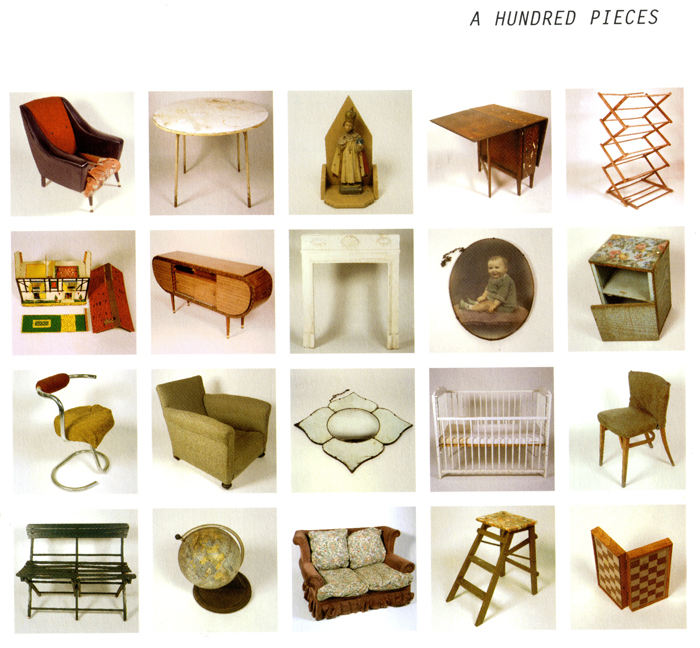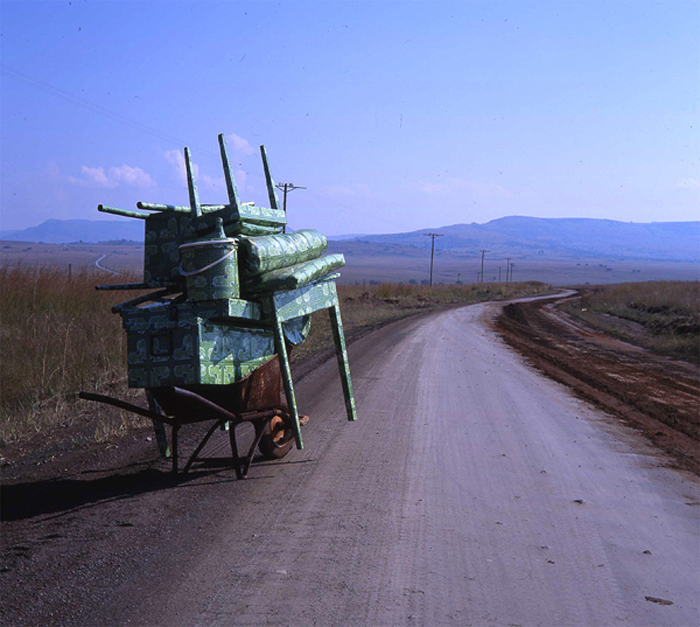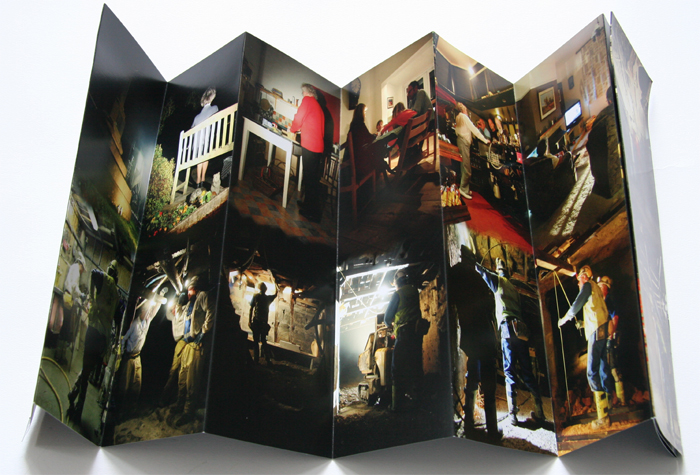
Casts –
In the period up to 1995 Neville Gabie worked extensively casting aluminum into pre-carved or constructed wooden forms. This lead onto three commissions working with an iron foundry, Cerdic Foundry, in Chard, Somerset. One work is installed in Chard High Street – 1990, one in Sandford Park, Cheltenham 1993 and one at Milfield School 1995
Kilns –
In the period up to 1995 Neville Gabie worked extensively firing clay within pre-carved and constructed wooden kilns. Both these works and the works with aluminum are as much about the process as the objects. This more than any other factor links them directly to the temporary works of that time. One of these kilns, made in 1987 is in the Arts Council Collection

Temporary Works Pre 1996
Between 1986 – 1996 Neville Gabie developed a number of temporary works in streets, rubbish dumps, demolition sites and building sites which are the precursor. They remain significant if not fully resolved works.
1 Untitled – made in a rubbish dump in Finchley, London using found materials 1986
2 Untitled – made in a street in North London in a hired skip placed alongside a builders skip and using their waste bricks 1987
3 Untitled – made on a building site in Cheltenham 1988
4 Untitled – made on a building site in Exeter 1990
5 Untitled – made in a buildinfg site in Exter 1990
6 Untitled – made in a forest uotside Berlin, Germany 1995
7 Unearthed – Camden Arts Centre 1987/88. In doing some research Neville Gabie found that the garden of the arts centre was a former World War 2 bomb site. With careful excavation he revealed foundations of the former building. He then dug a quantity of clay from the garden, constructed a kiln onsite and fired 500 hand made bricks. He used the bricks to reconstruct part of a wall, allowing the shift in alignment of the foundations to dictate the form of the wall. The clay pit, remains of the kiln and brick wall were left onsite for exactly one year before being re-buried.
8 Unearthed – Camden Arts Centre 1987/88
9 Unearthed – Camden Arts Centre 1987/88
10 Unearthed – Camden Arts Centre 1987/88
11 Untitled – Windsor Forest and the Royal College of Art, London 1988. An entire Chestnut tree, including roots, trunk and all branches cut into cubes, stacked and packed in the gallery. Prior to cutting, sections of the tree were photographed and life size photographs were placed in the forest in the location of the original.
12 Untitled – Windsor Forest and the Royal College of Art, London 1988

MOMART Artiist in Residence, Tate Liverpool 1999/2000
In 1999 Neville Gabie was appointed artist in residence at Tate Liverpool. Whilst there he developed a series of works responding the the empty feeling and sense of dilapidation in the city at the time. Under the heading ‘An A-Z Of Empty Spaces’ he made three specific works.
Paradise Street – a walk around the whole city relocating household rubbish found on the streets
One Hundred Pieces – a hundred items of furniture found on streets, each photographed and catalogued with date and location of find recorded.
Triangular Trading – red, yellow and blue objects found on the street traded between the locations of the three ferry crossing points on the Mersey, Wallasey, Birkenhead and Pier Head
It was whilst working as artist in residence at Tate Liverpool that Neville Gabie first came accross the three tower blocks in North Liverpool and began developing an idea for what eventually became Up In The Air

V=B0+B1*D^B2+B3*D^B4*H^B5
Royal Botanical Garden, Hamilton, Canada 2008
The work is based on a simple mathematical formula used in forestry to calculate the total cubic volume of wood in a tree by measuring its girth and height whilst it is still standing. Using the formula the science and conservation team at RBG calculated the total volume of a Red Oak, killed by Gypsy Moth, before it was cut down. The resulting work uses the entire tree from the largest to smallest sections, cut into cubes and packed as a solid volume. Located where it was felled the work is as much about the space left in the canopy above as it is about the wooden mass.
The work was a direct development from Raw, a previous work commissioned by the Forest of Dean Sculpture Trail

Artist in Residence – Vitamin Creative Space, Guangzhou, China
In 2004 Neville Gabie was invited to spend 6 weeks at Vitamin Creative Space in Guangzhou, China as artist in residence. Developed and funded by the Arts Council and the British Council and working with partners in China, this was part of an extensive programme of exchange opportunities.
Whilt in Guangzhou Neville Gabie developed an range of works most notably ‘Cultural Exchange’ where six unemployed Chinese workers were employed for one day, each given a small budget and asked to go and buy clothing for Neville to wear whilst in China. Each was documented individually prior to Neville adopting the clothing to use whilst working over the residency.
Other work included ‘Workstation’, sound recordings and film footage of street vendors seats and benches. This body of work remains incomplete.

Pomeroy to Maria Ratchitz – Dundee, Kwa-Zulu-Natal, South Africa 1996
During 1995/6 Neville Gabie did a teaching exchange with South African artist Jeremy Wafer taking up his post in the sculpture department at the Natal Technikon in Durban South Africa.This time back in his native South Africa was one of the most significant in terms of defining his practice. As well as a step away from a formal and material based sculptural practice, it gave him the confidence to embrace a direct response to a landscape outside the gallery with a series of temporary interventions and time based works.
Between 1995 /98 he developed a body of temporary works which were exhibited as a two person exhibition with Alastair Whitton at the NSA Gallery in Durban, the Tatham Gallery, Pietermaritzburg the ICA Gallery Johannesburg and Gasworks, London. Work from this series was purchased Carnigie Gallery, Newcastle, South Africa.
It was whilst in South Africa in 1995 that Neville Gabie first began photographing ‘found’ goalposts in an ongoing project which extends to numerous exhibitions and three publications. Please see Posts

Navigating History/ 10/9 – Lewes East Sussex 2004/05
Commissioned by Deborah Smith and Alice Angus to work in response to the East Sussex Archive in Lewes, East Sussex. In response to the project Neville Gabie chose to develop his own archive inviting anyone within East Sussex to contribute using their own diary entries from September 10th 2001 – the day before the twin Towers in New York were destroyed. The intention was to consider what an ordinary day in a small English community was like in the hours before 9/11. The work was first exhibited as a series of billboard images taken from the diary contributions. A publication was printed the following year using the diary entries along with a specially commissioned poem notes to my future self – by Brighton based poet Ros Barber
10/9 notes to my future self – Publication ISBN 978-0-9556168-0-8Introduction Text Elisabeth Hughes – East Sussex Archive
Project co-ordination Frances Lord. Publication design Alan War Axis Graphic Design Project funded; East Sussex Arts Partnership, Arts Council England

Outfield – Afghan Refugee Camp, Quetta, Pakistan 2005
Developed in partnership with Art Review Magazine and the NGO Right To Play
In 2004/05 Neville Gabie was invited by Art Review Magazine and the NGO, Right To Play to visit several Afghan Refugee Camps in Pakistan where the charity was running projects. The invitation was to make a body of photographic works which would be published by Art Review and exhibited by Right To Play during the Turin Winter Olympics. Work was then auctioned to raise funds for the charity.
Working in several refugee camps close to Quetta and Peshawar on the Pakistan, Afghanistan border, Neville Gabie chose to document informal cricket matches and detail photographs of children at play.

Underneath Above
Combe Down Bath 2008/09
Commissioned by Frances Lord and Steve Geliot to develop a project in response to the filling of the Combe Downs Stone Mine. Using detailed maps of mine routes under the village of Combe Down, Neville Gabie developed a body of photographs, a photograph taken underground juxtaposed with a photograph from what is directly above. The work was produced as a fold-out leaflet distributed locally and as a series of large scale light boxes, three of which are on display in the village.
A publication of all the commissions was published see; www.loupdesign.co.uk/combe_downs.php


Raw
Commissioned as Lead Artist to develop a new work for the Forest of Dean Sculpture Trail and to curate a programme of temporary projects in 2000/01.
‘Last year whilst walking around the forest I noticed a group of trees marked with white lines. In conversation with a forester I was told that these trees were being measured annually to calculate their volume and growth rate. It lead me to thinking – How would you calculate the volume of so random a form as a tree? What would that volume look like if you changed it’s shape and what space would it’s absence create in the canopy if a mature tree was removed?’
A desire to explore some of these questions was the basis of this work. Selecting a mature Oak in a dense stand of tree, it was carefully cut down, every piece being processed into cubes of wood. The final work is a solid cube of material constructed using every piece. It sits in an open space once occupied by the tree, marked now by a space in the canopy above.
www.forestofdean-sculpture.org.uk
Underneath
was a programme of temporary works by four artists/groups invited and curated by Neville Gabie with the support of Bruce Allan and Sam Wilkinson. The artists; Reinhild Beuther, Stefan Gec, Philip Reilly, Filmbrigade Nord developed a range of works including film screenings, projections, choir performances, photography and work with a local brick factory.

































































































